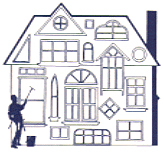| Vol. 4, No.
7 |
From the desk of ...
Arthur S. Lazerow |
ALBAN
Home Inspection
Service
To: All Listing Agents
(Part 2 of 3) |
As promised in our last issue, we are focusing on EXTERIOR
MAINTENANCE. Ask any potential buyer to describe a previously visited home and typically
only the front exterior appearance is described. Here's a list of exterior improvements to
achieve every Realtor's goal of a quick sale, maximum price and problem free home
inspection.
1. Regrade any area holding water near the foundation. Check for proper grades under
decks. 2. Improve cosmetics - prune trees and shrubs, clean gutters, freshen flower beds,
recaulk and repaint exterior woodwork, if necessary. 3. Point up eroding mortar joints in
brick work. Repair any cracks in block foundations. 4. Seal all penetrations of utility
lines through exterior walls. 5. Pay attention to chimneys. Point up masonry chimney
cracks and eroding mortar joints. Repair the chimney mortar cap. 6. Replace and paint any
rotted trim or siding. 7. Inspect roof and flashings. Ensure pipe flashings (boots) are in
good condition, repair any shingles whose nails show and reseal any loose flashing.
This list, with the exception of cosmetics, represents the most common exterior
deficiencies found during our home inspections. Next month we'll cover interior
improvements.
|

|
573 Lancaster Place
Frederick, Maryland 21702
Metro 1-800-822-7200
301-662-6565 |
Full Fee Refund
IF SALE DOESN'T CLOSE |
|
How To Tell If A
House Is Well-MaintainedThere are several
basic items to check when examining and maintaining the finer details of a home:
Heaters and boilers: Check the maintenance records of the unit to
see if it was serviced annually. Like most mechanical objects, regular maintenance is the
key to long life. Heating systems last longer in the presence of well-maintained windows,
extra insulation, and weather stripping and caulking.
Water damage: Windows and doors should be regularly painted and
caulked to prevent external water damage. Internally, water can be the biggest
troublemaker in bathrooms. Tile grout and shower caulking should be secure and watertight
to ensure that there is no damage to the wall. Proper maintenance can eliminate the need
to eventually replace damaged materials.
Appliances: Follow the manufacturer's directions and pay special
attention to the refrigerator (vacuum the coils for more efficient cooling) and dishwasher
(frequently clean the food trap). refrigerator (vacuum the coils for more efficient cooling) and dishwasher
(frequently clean the food trap).
Bathrooms: Besides maintaining the grout and caulk, make sure there
is a vent to the outside. As an alternative to separate tiles, vinyl floor covering can
prevent water seepage.
Doors: Exterior doors should be painted periodically to deter rust
and rot. Weather stripping should also be secure and fit tightly to prevent heat loss and
water entry.
Foundation: Surface water should be diverted as far as possible
away from the house. Good diversion practices include gutters and downspouts with splash
blocks, which should take water at least three feet away from the house, and proper soil
grading away from the home.
Heat pumps and central air conditioning: Annual service should
include checking the thermostats, switches, bearings, and refrigerant levels. A dirty
filter or coil compromises efficiency, increases strain on the fan motors, and ultimately
shortens the life of the unit.
Siding: Wood siding should be regularly painted and sealed to
reduce the risk of mildew, warping, rotting, and cracking. Aluminum and vinyl siding
should be cleaned regularly.
Septic system: Pumping the septic system is absolutely necessary to
maintain a functional system and prolong life. Depending on the number of people using the
system, it should be pumped every one to three years.
Water heater: The heater should be drained according to the
manufacturer's recommendation. Older units should be wrapped to increase efficiency, but
this is not necessary with newer models.
Roof: Roofs in the South last only 75% as long as those in the
North due to higher temperatures. The sun causes more damage to roofs than rain or snow.
To increase the life expectancy of a roof, consider installing soffit and ridge vents,
choosing lighter-colored shingles, and increasing the pitch of the slope. A
thermostatically controlled roof fan can also help to reduce heat and maintain a cooler
temperature in the home during the warmer months. |
|
| || Next Page || Back to Index Page || Alban Home || |
|